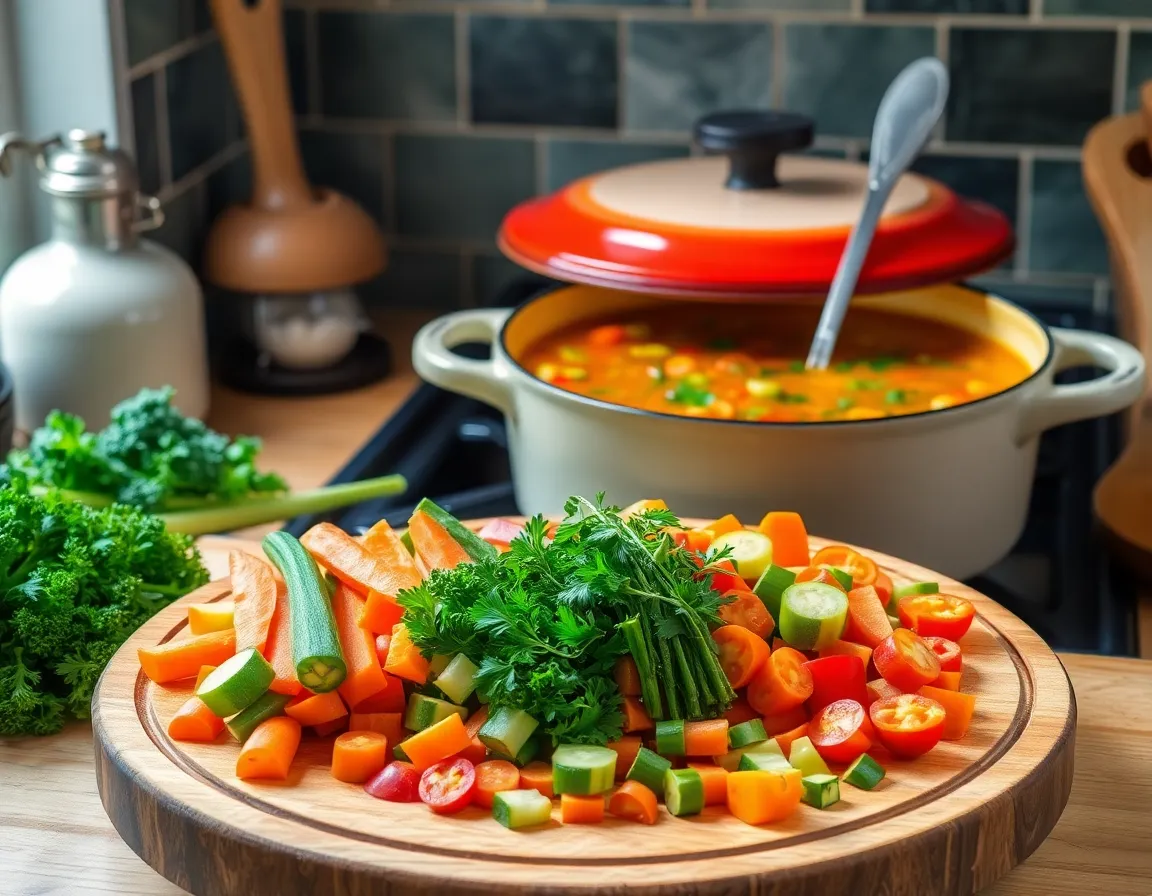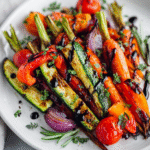Welcome to a warm embrace in a bowl, where vibrant colors and fresh aromas invite you to savor every spoonful. This vegetable soup is a celebration of nature’s bounty, perfect for both kitchen novices and seasoned chefs looking to enjoy a meal that’s as comforting as it is nourishing. Imagine the gentle simmer of a medley of garden-fresh vegetables, each releasing its unique fragrance and flavor, creating a symphony of taste that dances on your palate.
What makes this soup truly special is the harmonious blend of earthy carrots, sweet corn, and savory herbs, all coming together to create a deliciously satisfying experience. Whether it’s a chilly evening or a cozy lunch, this recipe offers a delightful way to enjoy wholesome ingredients while feeling confident in your culinary skills. With simple steps and easily accessible ingredients, you’ll find joy in the process and pride in the delicious results.
About This vegetable soup Recipe
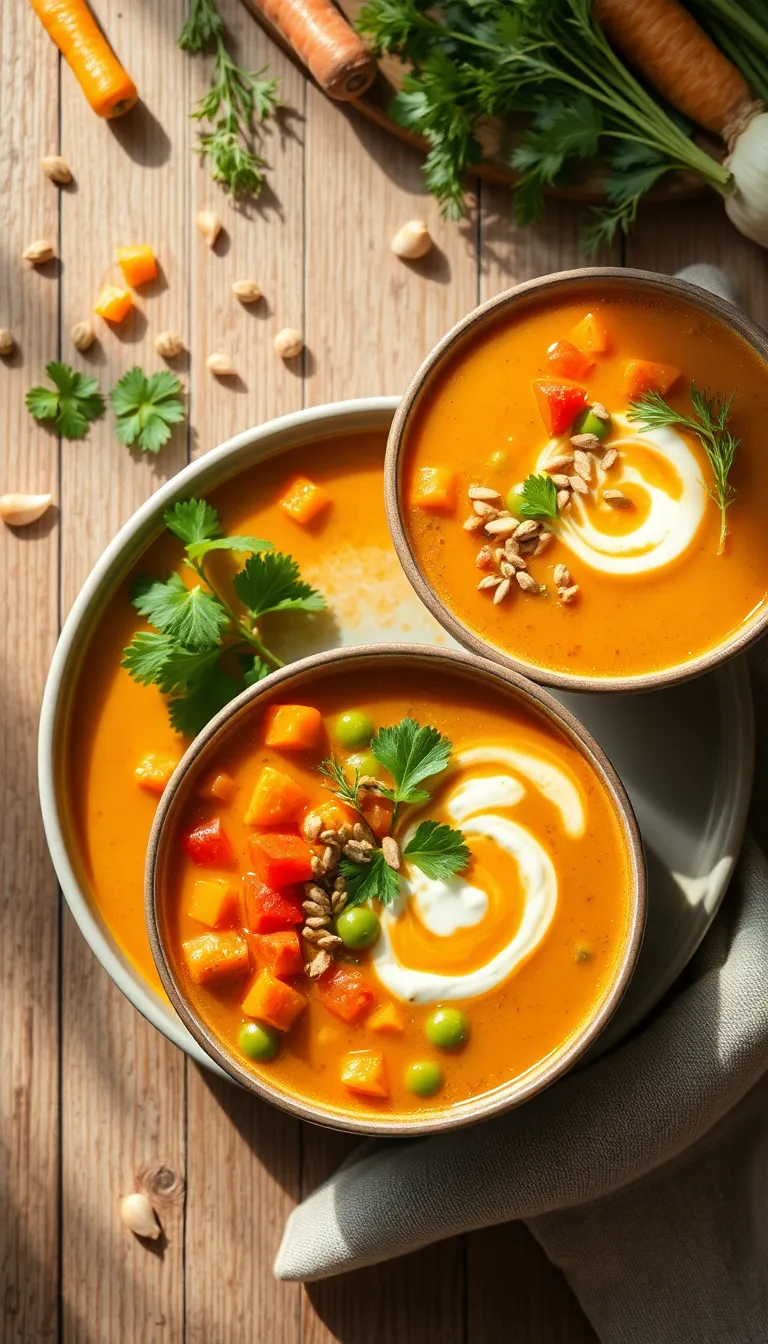
- Quick and Easy: This vegetable soup is ready in just under 30 minutes, making it perfect for busy weeknights.
- Flavorful and Nourishing: Packed with a variety of fresh vegetables, this soup delivers a burst of flavors in every spoonful.
- Customizable: Easily adapt this recipe to include your favorite seasonal vegetables or whatever you have on hand.
- Healthy and Light: Low in calories yet rich in vitamins, it’s a guilt-free choice that supports a balanced diet.
- Warm and Comforting: Perfect for chilly days, this soup is like a warm hug in a bowl, bringing comfort and satisfaction.
Why You’ll Love This Recipe
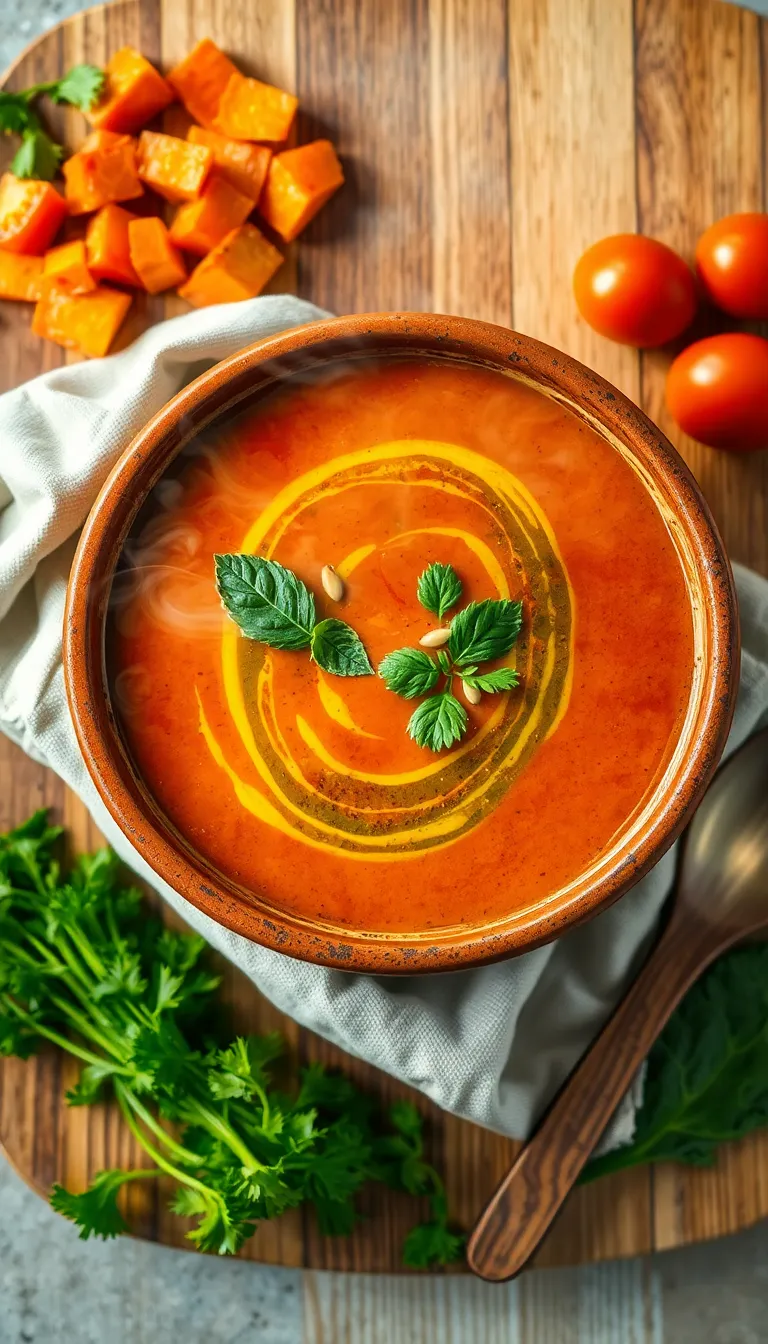
- Quick and Easy: This vegetable soup comes together in just under 30 minutes, making it perfect for busy weeknights when you need a wholesome meal fast.
- Flavorful and Satisfying: Packed with a variety of fresh vegetables and herbs, every spoonful bursts with vibrant flavors that make healthy eating a delight.
- Customizable: You can easily adapt this recipe to suit your taste or use up whatever veggies you have on hand, ensuring zero waste and endless possibilities.
- Nutrient-Rich: Loaded with vitamins, minerals, and fiber, this soup supports a balanced diet while keeping you full and energized throughout the day.
- Perfect for All Seasons: Enjoy it as a warm comfort during colder months or a light, refreshing option in the summer — it’s versatile and delicious year-round.
Ingredients
- 2 tablespoons olive oil
- 1 large onion, diced
- 3 cloves garlic, minced
- 2 carrots, sliced
- 2 celery stalks, sliced
- 1 bell pepper, diced
(Red, yellow, or green peppers can be used based on preference)
- 4 cups vegetable broth
(Low-sodium preferred for better control of seasoning)
- 1 can (14.5 ounces) diced tomatoes
- 1 teaspoon dried thyme
- 1 teaspoon dried oregano
- 1/2 teaspoon dried basil
- 2 potatoes, peeled and diced
- 1 cup green beans, chopped
- 1 cup corn kernels
(Frozen or fresh)
- 1 cup peas
(Frozen or fresh)
- Salt and pepper to taste
- 1 tablespoon lemon juice
(For a touch of brightness)
- 1/4 cup fresh parsley, chopped
(Optional, for garnish)
- Grated Parmesan cheese (optional)
(For serving)
Kitchen Tools You’ll Need
- Large Pot: Essential for cooking the soup. A pot with a capacity of at least 6 quarts will allow you to comfortably simmer all ingredients without spillage.
- Cutting Board: Used for chopping vegetables. A stable, non-slip cutting board will make preparation safer and more efficient.
- Chef’s Knife: Crucial for slicing and dicing the vegetables. Ensure it’s sharp for more precise cuts and to make prep work easier.
- Wooden Spoon: Ideal for stirring the soup as it cooks, helping to evenly distribute heat and flavors.
- Ladle: Necessary for serving the soup. If you don’t have a ladle, a large spoon can be used as an alternative.
- Measuring Cups and Spoons: Important for accurately measuring ingredients such as broth and seasonings to achieve the right flavor balance.
- Peeler: Useful for peeling vegetables like carrots and potatoes. If you don’t have a peeler, a small paring knife can be used carefully.
- Colander: Helps with rinsing vegetables before chopping. If unavailable, a clean kitchen towel can be used to pat vegetables dry.
Preparation Steps
Preparation Steps
- Chop all vegetables into bite-sized pieces, ensuring uniform size for even cooking.
- Heat 2 tablespoons of olive oil in a large pot over medium heat until shimmering.
- Add onions and garlic to the pot and sauté for 3-4 minutes until onions are translucent and fragrant.
- Stir in carrots, celery, and any other root vegetables, cooking for an additional 5 minutes until they start to soften.
- Pour in vegetable broth, bring to a boil, then reduce heat to a simmer, and cook for 15-20 minutes or until all vegetables are tender.
- Add leafy greens like spinach or kale during the last 5 minutes of cooking, stirring until wilted.
- Season the soup with salt, pepper, and herbs to taste. Adjust seasoning gradually to avoid over-salting.
- Serve hot, garnished with fresh parsley or grated cheese if desired.
Serving Suggestions
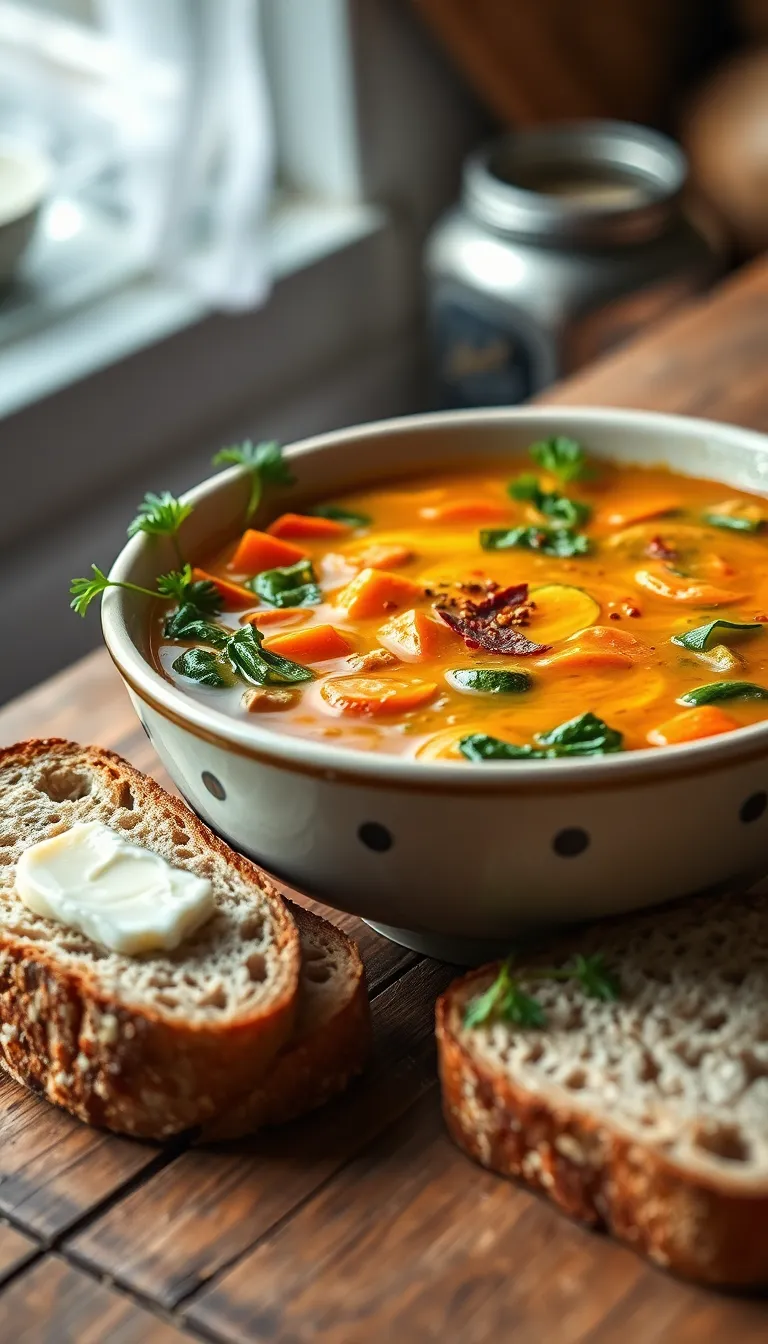
- Crusty Bread: Serve the vegetable soup with a slice of freshly baked crusty bread. The bread’s texture complements the soup’s warmth and offers a satisfying contrast.
- Herb Garnish: Sprinkle freshly chopped herbs like parsley or basil over the soup just before serving. This adds a pop of color and enhances the soup’s fresh flavors.
- Grated Parmesan: Add a sprinkle of grated Parmesan cheese on top to introduce a rich, savory depth that pairs beautifully with the soup’s vegetable base.
- Side Salad: Pair the soup with a simple mixed green salad drizzled with a light vinaigrette. This combination makes for a refreshing and balanced meal, perfect for lunch or dinner.
- Wine Pairing: Enjoy the soup with a chilled glass of Sauvignon Blanc. The wine’s crisp acidity complements the soup’s flavors, enhancing the overall dining experience.
- Cheesy Toast: Serve with a slice of toast topped with melted cheese, such as Gruyère or Cheddar. The creamy, cheesy goodness elevates the comforting nature of the soup.
Pro Tips for Perfect Results
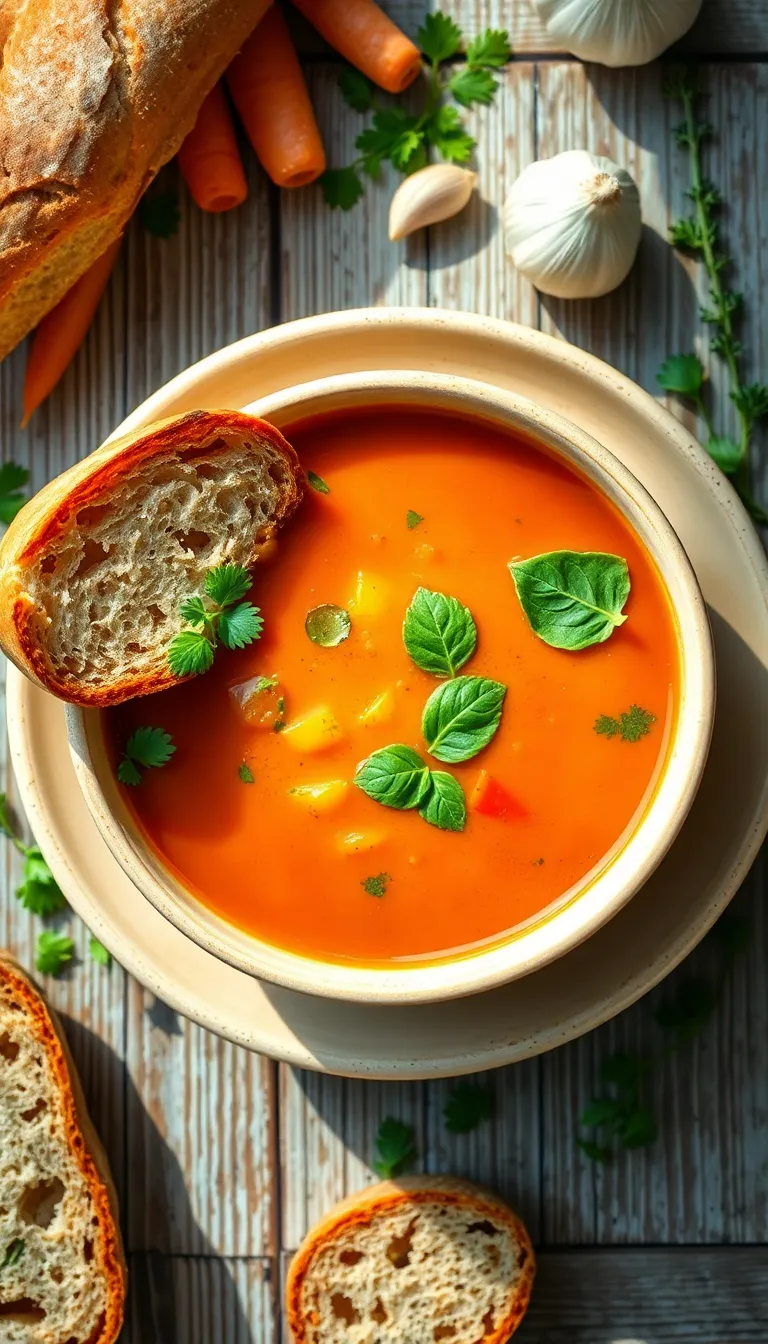
- Roast Your Vegetables: Before adding vegetables to your soup, try roasting them in the oven at 400°F (200°C) for about 20 minutes. This enhances their natural sweetness and adds a depth of flavor to your soup.
- Layer Flavors with Herbs: Add herbs like thyme or rosemary early in the cooking process, and finish with fresh herbs such as parsley or dill just before serving for a layered flavor profile.
- Use Homemade Stock: If possible, use homemade vegetable stock instead of store-bought for a richer, more natural taste. This can be made ahead and frozen in portions for convenience.
- Don’t Forget the Acid: Brighten up your soup with a splash of acid, like lemon juice or vinegar, just before serving. This small touch can significantly enhance the overall flavor.
- Finish with a Touch of Umami: Stir in a teaspoon of soy sauce or miso paste towards the end of cooking to add a subtle umami depth that will elevate the soup’s flavor.
- Make-Ahead for Enhanced Flavor: Vegetable soup often tastes better the next day. Prepare it in advance and let it sit overnight in the refrigerator to allow the flavors to meld.
Common Mistakes to Avoid
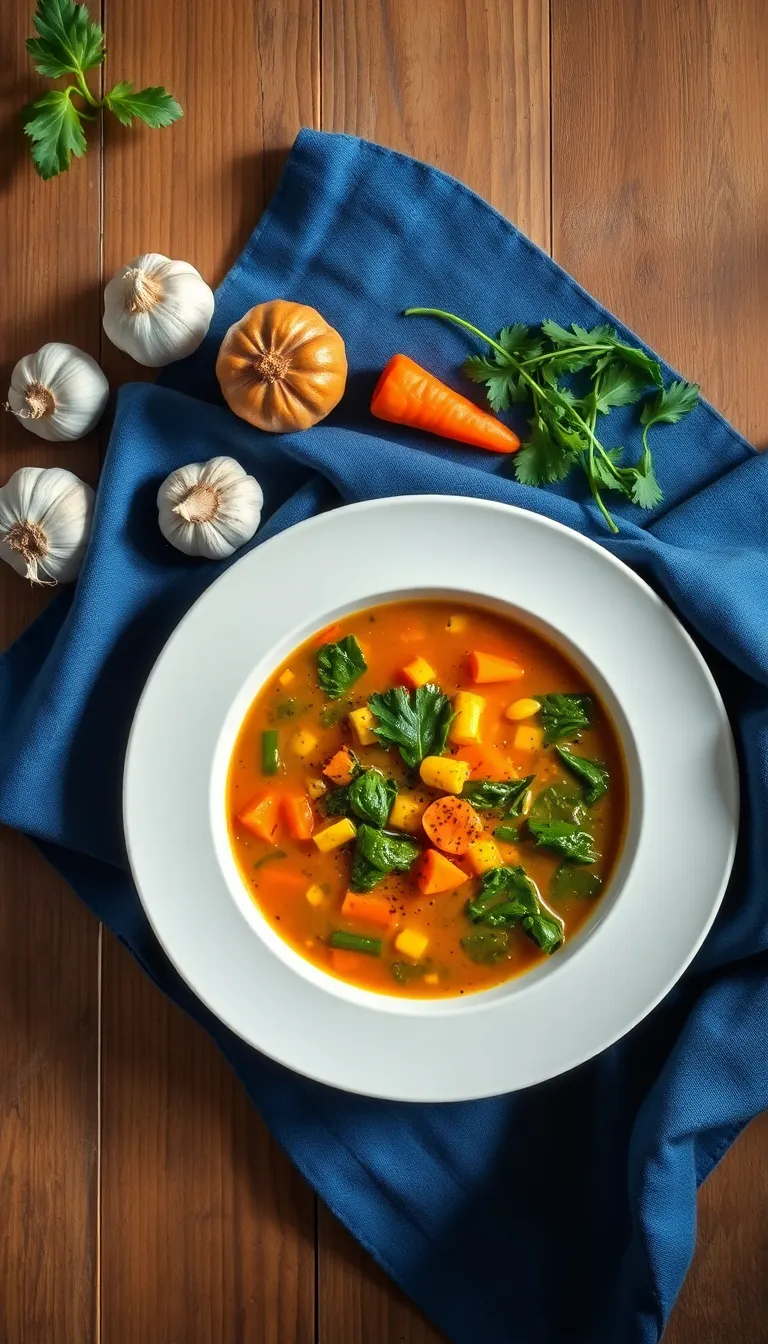
- Not Sautéing Vegetables First: Skipping the sautéing step can lead to a bland soup. Sautéing helps to release and enhance the natural flavors of the vegetables. To avoid this, start by heating a little oil in your pot and cook the onions, garlic, and any hard vegetables like carrots and celery for a few minutes before adding liquid.
- Overcooking the Vegetables: Cooking the soup for too long can turn your vegetables mushy. To prevent this, add vegetables according to their cooking times, starting with the ones that take longer to soften and adding more delicate vegetables closer to the end of the cooking process.
- Adding Too Much Liquid: It’s easy to end up with a watery soup if you don’t carefully measure your liquid. Always start with less broth or water than you think you need and gradually add more as the soup simmers. This way, you can control the thickness better.
- Forgetting to Season Properly: Without sufficient seasoning, your soup might taste bland. Use salt and pepper judiciously, and consider adding herbs and spices for extra flavor. Taste the soup as it cooks and adjust the seasoning accordingly to ensure a well-rounded flavor.
- Using the Wrong Pot: Using a pot that’s too small can lead to uneven cooking and spills. Ensure you use a large enough pot to accommodate all ingredients with room to stir comfortably. A heavy-bottomed pot is ideal to distribute heat evenly and prevent sticking.
Storage and Reheating Tips
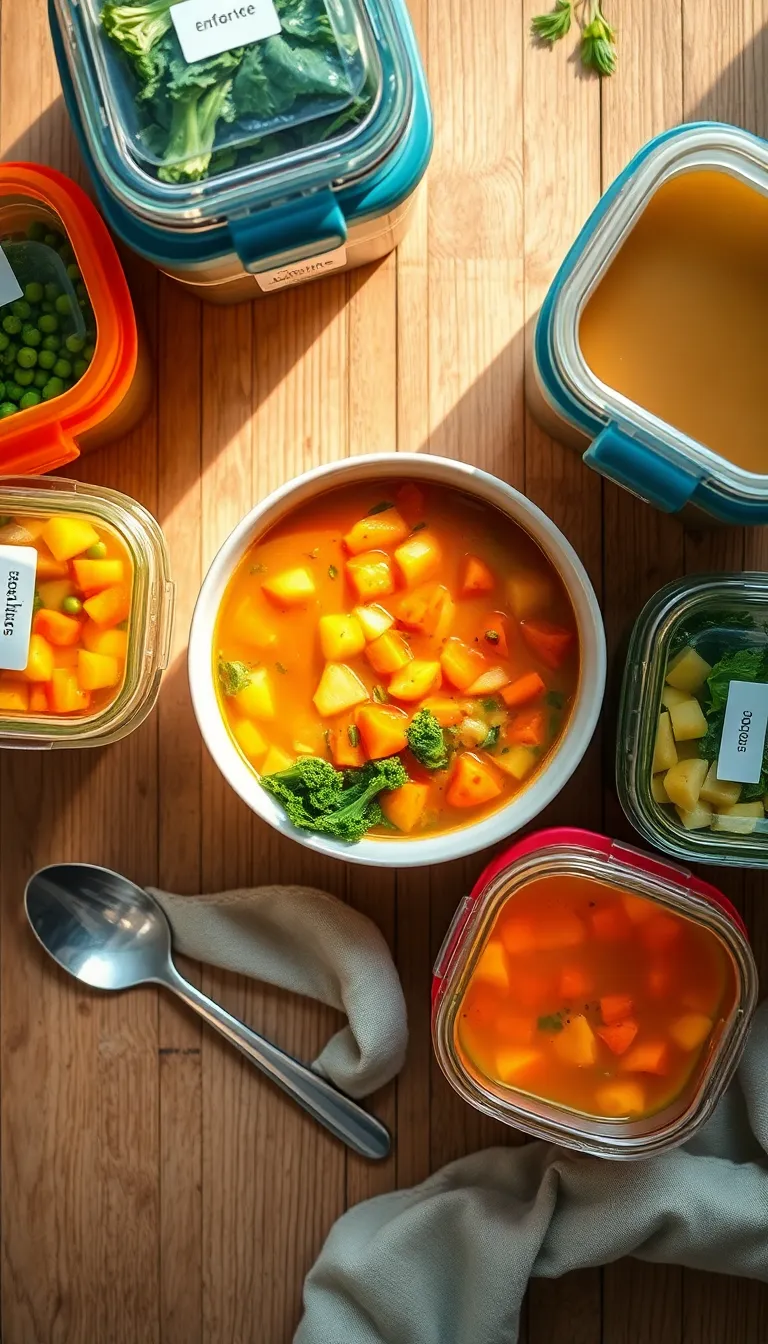
- Allow the vegetable soup to cool to room temperature before storing it to prevent condensation and potential bacterial growth.
- Transfer the cooled soup into airtight containers. Glass containers are preferable as they do not absorb odors and can be safely reheated in a microwave.
- Store the soup in the refrigerator for up to 3-4 days. Ensure that the refrigerator is set to 40°F (4°C) or below for optimal food safety.
- If freezing, portion the soup into freezer-safe containers or heavy-duty freezer bags, leaving some space for expansion. Label with the date before placing in the freezer.
- Vegetable soup can be frozen for up to 2-3 months. For best quality, consume within this timeframe.
- When ready to reheat, thaw frozen soup overnight in the refrigerator or use the defrost setting on your microwave.
- Reheat the soup on the stove over medium heat, stirring occasionally, until it reaches a simmer. This ensures even heating and helps maintain the soup’s texture.
- Alternatively, reheat in the microwave in 1-2 minute intervals, stirring in between, until the soup is heated through. Use a microwave-safe cover to prevent splatters.
- Ensure the soup reaches an internal temperature of 165°F (74°C) when reheating to ensure it is safe to consume.
- Avoid reheating the soup more than once to maintain its quality and safety.
Frequently Asked Questions
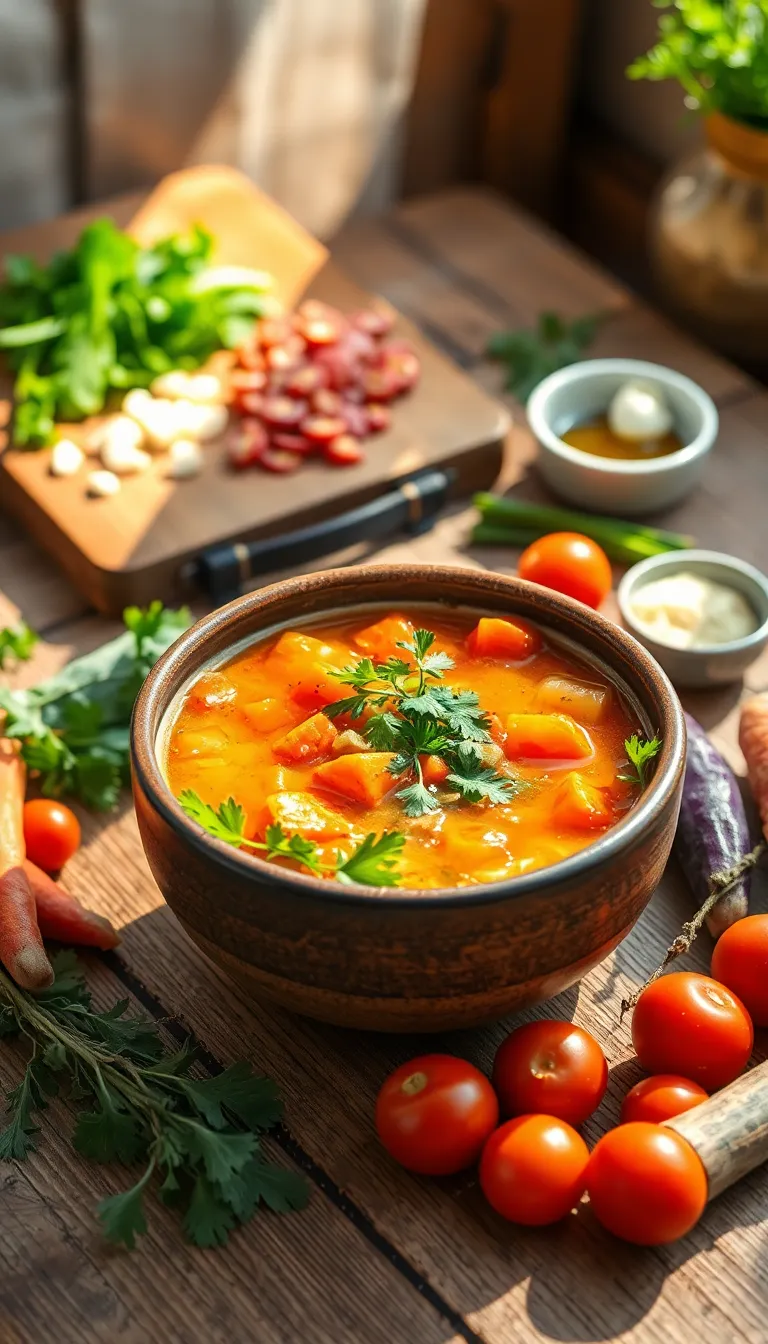
Q: Can I use frozen vegetables instead of fresh ones?
- Yes, you can use frozen vegetables. They are a convenient substitute and can be added directly to the soup without thawing.
Q: How do I make the soup more flavorful?
- Try adding herbs like thyme or rosemary, or enhance the flavor with a splash of vinegar or a squeeze of lemon at the end.
Q: What can I do if my soup is too salty?
- Add a potato to the soup and cook for a few minutes; it can absorb some of the excess salt.
Q: Can I make this soup in advance?
- Absolutely! The flavors often improve after a day, making it a great make-ahead option. Store it in the fridge for up to 3 days.
Q: How can I make this soup more filling?
- Consider adding beans, lentils, or quinoa for an extra boost of protein and fiber.
Q: Can I use a different broth instead of vegetable broth?
- Yes, chicken or beef broth can be used if you’re not strictly vegetarian, which will add different layers of flavor.
Final Thoughts
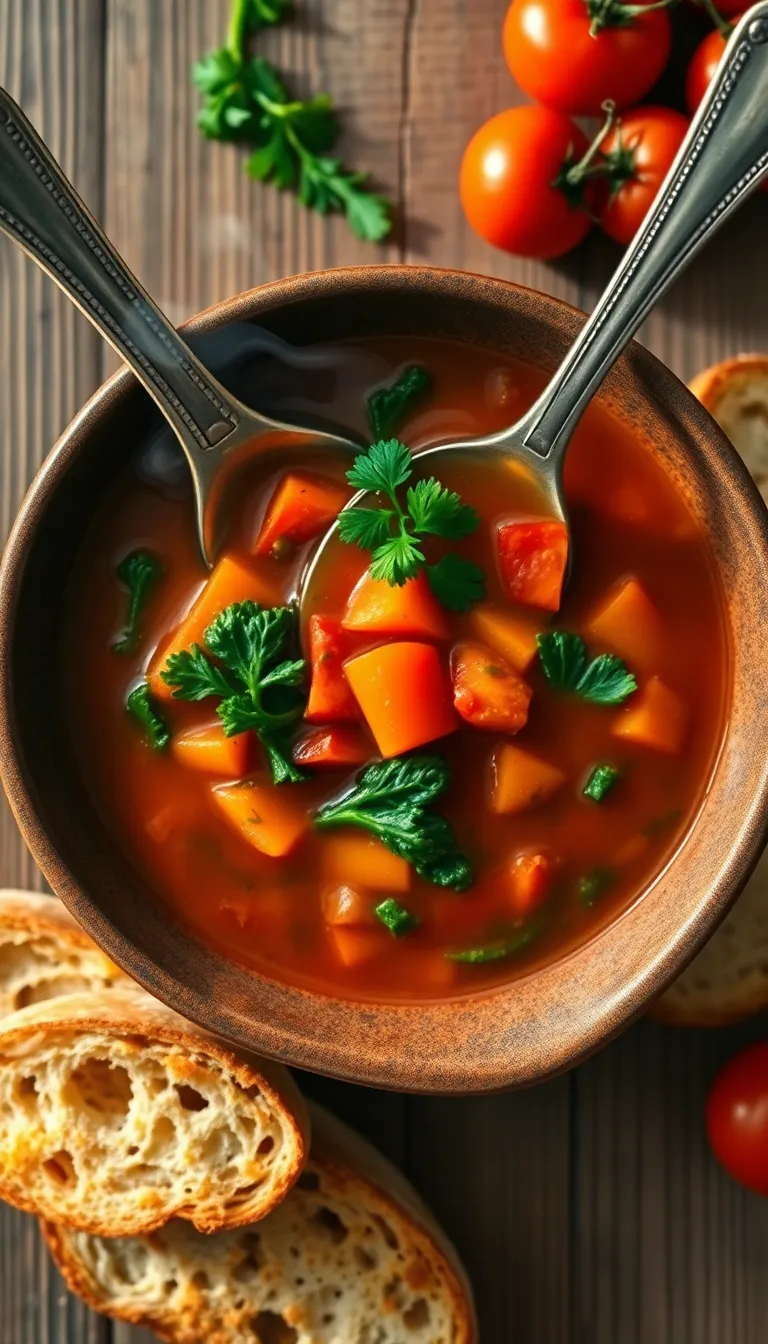
Our Vegetable Soup Recipe is a delightful combination of fresh, vibrant vegetables simmered in a hearty broth, making it a perfect dish for any season. This recipe stands out because of its simplicity and the wholesome flavors it brings to your table. It’s a nourishing choice that’s both easy to prepare and satisfying to eat, making it a must-try for anyone looking to enjoy a comforting bowl of soup.
Feel free to personalize this soup by adding your favorite herbs or spices, or even incorporating seasonal vegetables to make it truly your own. Don’t be afraid to experiment! The joy of this recipe lies in its versatility and the opportunity to tailor it to your taste preferences. Cooking is an art, and this vegetable soup serves as a wonderful canvas for your culinary creativity.
We warmly invite you to try this recipe and experience the delightful harmony of flavors it offers. Whether you’re a seasoned cook or just starting out, this vegetable soup is sure to become a beloved addition to your recipe repertoire. Enjoy the process and the delicious results!

I’m Jonny, the cook, writer, and food lover behind this flavorful corner of the internet. Whether it’s a sizzling weeknight stir-fry, a no-bake dessert that saves the day, or a comforting Sunday classic — this blog is where I share recipes that are bold, doable, and made to impress without the stress.

